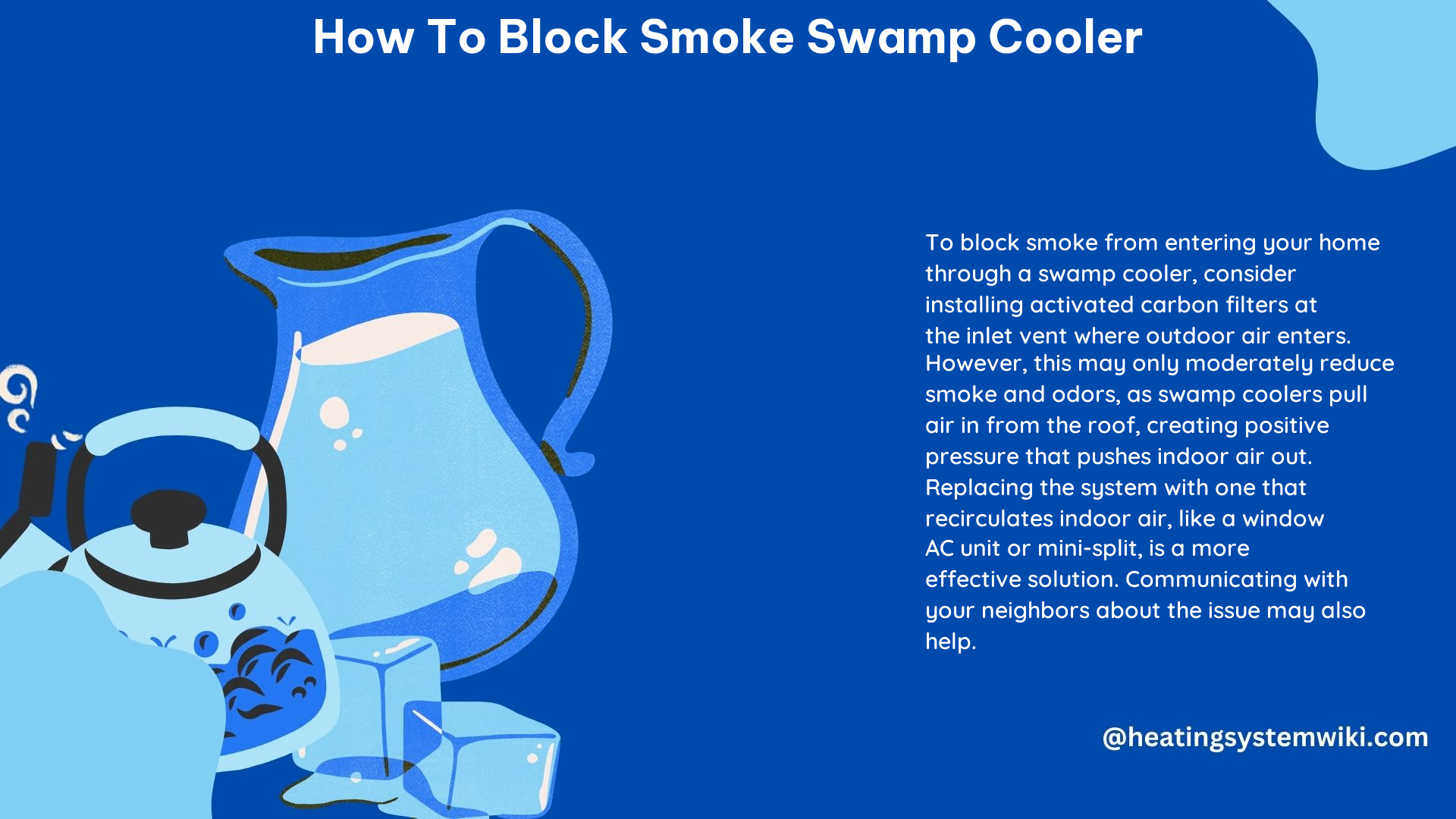Swamp coolers, also known as evaporative coolers, are a popular and cost-effective way to cool homes, especially in dry climates. However, during wildfire seasons or in areas with high air pollution, these coolers can inadvertently draw in and circulate harmful smoke and particulate matter into the home. To effectively block smoke from entering a home through a swamp cooler, there are several advanced techniques and solutions that can be implemented.
Understanding Swamp Cooler Operation and Smoke Infiltration
Swamp coolers work by drawing in warm, dry air from the outside and passing it through water-soaked cooling pads. As the air passes through the pads, the water evaporates, cooling the air and increasing its humidity. This cooled, damp air is then blown into the home, providing a refreshing and energy-efficient cooling solution.
However, during wildfires or in areas with high air pollution, the outside air that is drawn into the swamp cooler can contain a significant amount of smoke, ash, and other particulate matter. These pollutants can then be circulated throughout the home, exposing the occupants to potentially harmful respiratory conditions, such as asthma, heart disease, and other health issues.
Installing MERV 13 Filters on Swamp Coolers

One of the most effective solutions to block smoke from entering a home through a swamp cooler is to install MERV 13 filters. MERV, or Minimum Efficiency Reporting Value, is a rating system that measures a filter’s ability to capture particles of various sizes. MERV 13 filters are particularly effective at capturing the smallest pollutants found in wildfire smoke, including fine particulate matter (PM2.5) and ultrafine particles (PM1.0).
According to the research conducted by Gina Soloman, the lead investigator of the Filtration for Respiratory Exposures from Swamp Cooler Air (FRESSCA) project, MERV 13 filters have been shown to reduce particle pollution in homes by up to 90%. Soloman and her team have been collecting data from mobile homes in the cities of Coalinga, Avenal, Huron, and Kettleman City since 2020, and they have recently developed a prototype model of a filtration system that they have installed in homes earlier this summer.
To install a MERV 13 filter on a swamp cooler, follow these steps:
- Measure the size of the swamp cooler’s air intake opening to determine the appropriate filter size.
- Purchase a MERV 13 filter that fits the dimensions of the air intake opening.
- Carefully remove the existing filter (if any) and replace it with the MERV 13 filter, ensuring a tight seal.
- Regularly inspect and replace the MERV 13 filter as recommended by the manufacturer, typically every 3-6 months, to maintain optimal filtration performance.
Wrapping Thin, Carbon-Lined MERV 13 Filters
Another effective solution to block smoke from entering a home through a swamp cooler is to wrap thin, carbon-lined MERV 13 filters onto the coolers. These specialized filters are designed to capture not only the larger particulate matter but also the smallest pollutants found in wildfire smoke, including those that may not be felt when breathed in but can still cause long-term harm.
The carbon lining in these filters helps to adsorb and remove volatile organic compounds (VOCs), gases, and odors that may be present in the smoke, further improving the indoor air quality.
To wrap thin, carbon-lined MERV 13 filters onto a swamp cooler, follow these steps:
- Measure the dimensions of the swamp cooler’s air intake and cooling pads to determine the appropriate filter size.
- Purchase thin, carbon-lined MERV 13 filters that can be easily wrapped around the cooler’s air intake and cooling pads.
- Carefully wrap the filters around the air intake and cooling pads, ensuring a snug and secure fit.
- Regularly inspect and replace the filters as recommended by the manufacturer, typically every 2-4 months, to maintain optimal filtration performance.
Replacing Swamp Coolers with Central Air Conditioning
For homeowners who are willing to invest in a more comprehensive solution, replacing the swamp cooler with a central air conditioning (AC) unit can be an effective way to eliminate the infiltration of outdoor air, including smoke and other pollutants, into the home.
Central AC units work by circulating and filtering the air within the home, without drawing in outside air. This can provide a more reliable and consistent indoor air quality, especially during wildfire seasons or in areas with high air pollution.
However, it’s important to note that replacing a swamp cooler with a central AC unit may not be a feasible solution for everyone due to factors such as cost, installation complexity, and the home’s existing ductwork and electrical infrastructure.
Conclusion
Blocking smoke from entering a home through a swamp cooler is a critical concern, especially in areas prone to wildfires or high air pollution. By implementing advanced solutions such as installing MERV 13 filters, wrapping thin, carbon-lined MERV 13 filters, or replacing the swamp cooler with a central air conditioning unit, homeowners can effectively improve their indoor air quality and protect their families from the harmful effects of smoke exposure.
Reference:
- Swamp Cooler: How to filter outdoor cigarette smoke – https://boards.straightdope.com/t/swamp-cooler-how-to-filter-outdoor-cigarette-smoke/716315
- Swamp Cooler Smoke Filter for Wildfire Smoke. PLUS More ways to … – https://www.youtube.com/watch?v=CZ1UqImfzz4
- Swamp coolers pump smoke into homes during wildfires. Experts see a solution in the Central Valley – https://www.kvpr.org/local-news/2023-08-17/swamp-coolers-pump-smoke-into-homes-during-wildfires-experts-see-a-solution-in-the-central-valley
